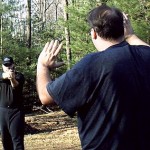 Let’s be honest: When someone points a gun at you, the chances that you will be shot no matter what you do are very high. You must decide, when facing a firearm, if you should comply or if you must resist. Know that any time you attempt a firearm counter you are risking grave personal injury or death. Proceed accordingly.
Let’s be honest: When someone points a gun at you, the chances that you will be shot no matter what you do are very high. You must decide, when facing a firearm, if you should comply or if you must resist. Know that any time you attempt a firearm counter you are risking grave personal injury or death. Proceed accordingly.
Your only options for dealing with a firearm at distance are to comply, to flee, or to rush the weapon. If the attacker is too far away to reach with a lunge, you’re basically out of luck. If you’re so far away that you can run, following an erratic course and taking advantage of environmental cover (cars, trees, corners, etc.), you have a chance. If you’re far enough away that you can’t reach the attacker and you can’t run without being shot, you can only rush the gunman and hope to reach him before he shoots you down. None of these are particularly pleasant propositions.
Anyone stupid enough to point a gun at you at extremely close range (almost touching you, for example) is doing you a favor. If you can touch the gunman, you can attempt a defense. The basic counters shown here are not really disarms as such, because we’re not focusing on taking possession of the gun. Instead, we seek only to control the barrel of the weapon as we deal with the assault.
There’s something else you must consider when contemplating firearms counters, too. If you redirect the barrel of an attacker’s weapon and that weapon discharges, that bullet is going to go somewhere other than into you. This could mean innocent bystanders will be shot with bullets intended for you. There are moral implications here that you must consider.
WARNING! Firearms are gravely dangerous. Do not attempt any firearms training with real weapons. Always use appropriate training tools and understand the risks of the techniques you are learning.
STICK ‘EM UP
From the typical “stick ’em up” position we’ll discuss two basic techniques. In the first, seen below, my teacher Dave points his pistol at me and demands my wallet. My hands are up and my day is ruined. Reasoning that he’ll kill me no matter what I do, I decide to fight.
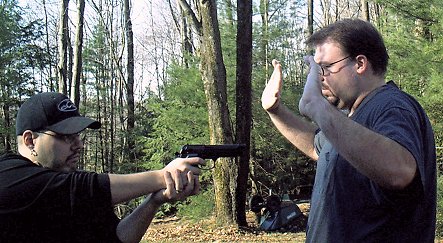
“Cup and saucer” grip is something you’ll see people do in real life. It’s a
corruption of a proper Weaver stance. Oh, and I’m being held up. Help!
When fired, the pistol is dangerous in only one direction: directly in front of the barrel. I must, therefore, twist my body and shove the barrel off line at the same time in order to increase my chances of avoiding that dangerous straight line.
Using the arm closest to the weapon (my left hand, in this case), I shove the weapon off line as I twist my torso to provide more clearance. This is spectacularly dangerous because I’m sweeping my own body with the barrel, if only for an instance. We’ve shown the pistol here with the hammer cocked Dave’s finger on the trigger for a reason. I could be shot at any time before or during my move.
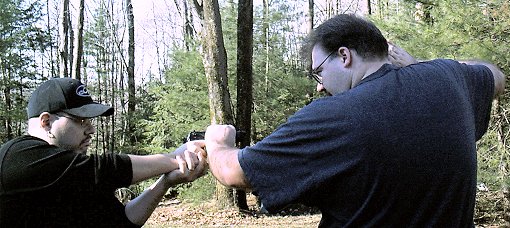
Turning and shoving the weapon’s barrel off line.
Provided I don’t get shot dead, I counterattack as I maintain my death-grip on the pistol. This must happen very fast, very viciously, and very ruthlessly. I should be trying to hit almost simultaneously (though obviously it will take an instant to perform this) for maximum effect.
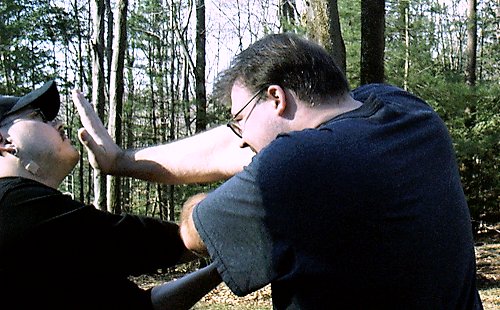
Clutching the weapon in a death grip, I counterattack as viciously as possible.
The other basic option we’ll demonstrate here was taught to me by Dan Webre. From the same “stick ’em up” position, I use my left hand again to clear the weapon, this time simply slapping the weapon away to the outside. I could try to grip it or I could simply be trying to shove the arm (though if I have no control over the weapon the danger to me increases). Simultaneously as I do this, I drive forward and shoot a web-of-hand blow to the gunman’s throat. It is this vicious attack that makes the technique viable; they must occur at exactly the same instant.
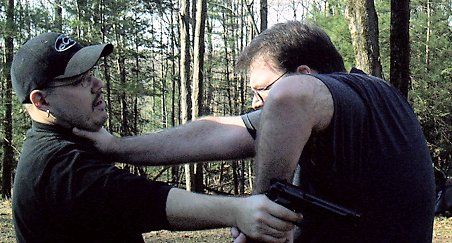
Simultaneous clearing of weapon with web-of-hand attack to the throat.
One other technique we’ll cover is for the stick-up from behind. If a gunman points a weapon at your back, especially if he obligingly pokes you with the barrel to prove that it is there, you could try an extremely risky torso twist to clear the weapon as you counterattack. This is wildly risky and you’ll probably be shot doing it.
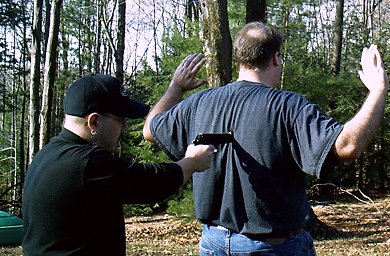
Dave again demands my wallet. I am about to do something very stupid.
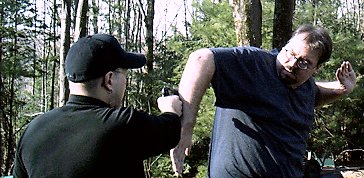
This is me doing something very stupid. It might work, but it probably won’t.
In the United States it is still legal for private citizens to carry firearms in many places. I am one such CCW license-holder. Turning the tables briefly, Dave and I thought it might be fun to illustrate the preferred defense for a mugging at knifepoint.
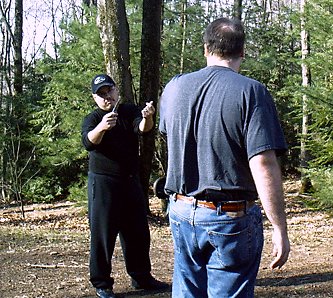
Dave approaches and tries to mug me at knifepoint.
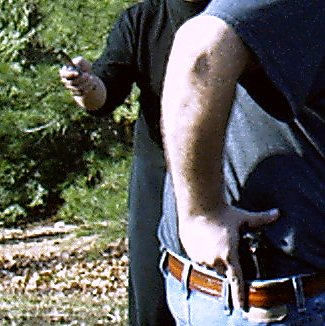
I’m indexing my weapon even as he does it. Because I have to reach
behind my body, I put out my off hand in a warding gesture.
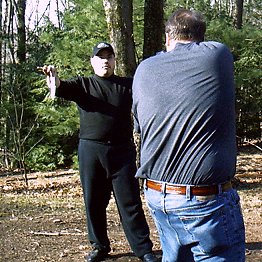
I now have him covered. If he doesn’t give up I
must shoot because he can close and stab me
very quickly at this distance.
The point here is that outside close range, the pistol will trump the blade. This does not mean you should not train with or carry both (provided you can do so legally). It simply means you must be aware of the advantages and disadvantages of the weapons you wield – and the weapons you face.
CARJACKING
Moving on to basic carjacking scenarios, Dave becomes the innocent motorist and I play the role of carjacker. If you are sitting in your car and someone tries to take it (or you) at gunpoint, the best thing you can do is duck-and-drive, flooring the accelerator and trying not to get shot. You may not be able to do this without ramming another car or driving into cross-traffic, however – which means you often won’t be able to drive anywhere. Smart carjackers will target you when and where you are boxed in.
Whenever possible, do not wait inside a parked car. You are begging to be carjacked in that position. Outside a coffee shop where I’ve waited many times, there was a carjacking at almost precisely the spot where I was parked a week previously. Carjackers are lazy thieves who never learned how to break in and hotwire vehicles. They’re looking for drivers in-vehicle whom they can threaten.
If you must sit inside a vehicle, of course, the best defense is a handgun of your own.
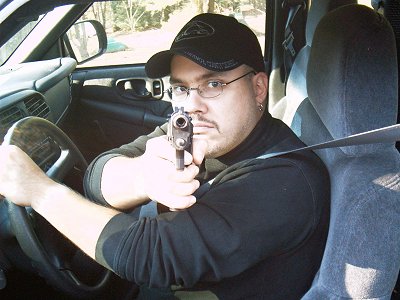
If that handgun cannot be readied and fired with one hand, you are at a disadvantage.
Next we’ll look at two possible unarmed defenses against a carjacking. In the first, drive Dave is at a heavy disadvantage because I’ve approached him from behind and at an angle.
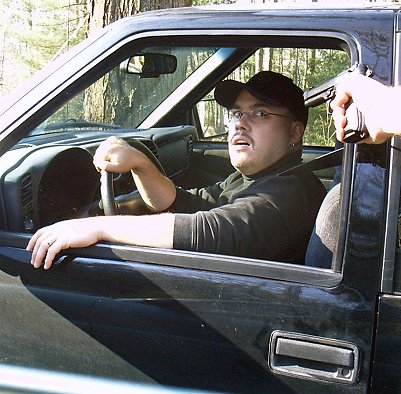
Dave is approached from behind and at an awkward angle.
He hasn’t got a great set of choices available. One response is to stomp on the gas. Another is opening his door as quickly as possible, followed by a counterattack.
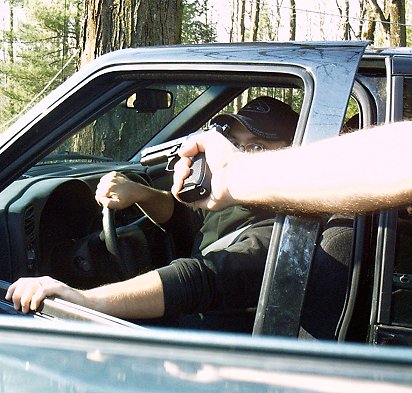
He whips his door open with as much force and speed as he can,
taking me by surprise. This is very dangerous for him.
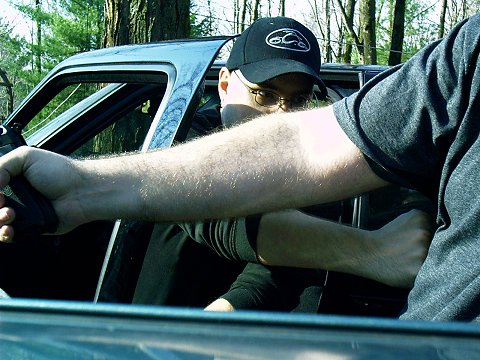
Surging forward, he attempts to exit the vehicle to counterattack. Could he make it? The chances aren’t good, but they’re better than sitting and waiting for the bullet if he thinks I won’t be satisfied taking his money or his car.
From a slightly better angle, Dave can try to pin the weapon against the door in pushing the barrel off line. He can then yank the weapon forward, counter-attacking.
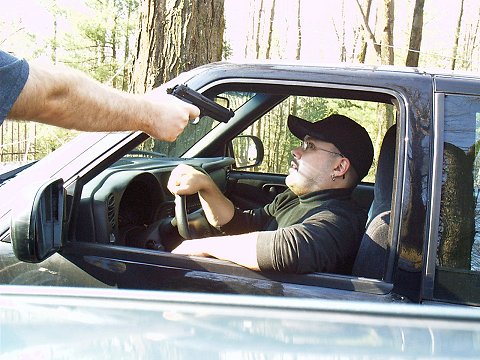
I approach Dave from the front of the vehicle. For whatever reason he thinks he
will be killed even if he complies.
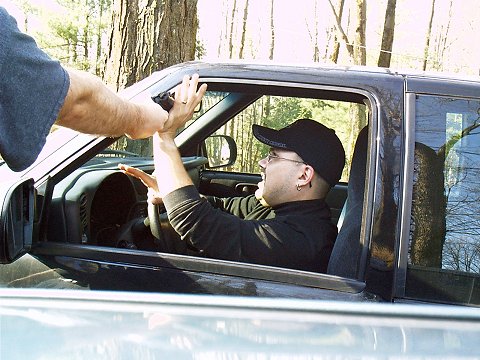
From the hands-up posture he quickly shoves the barrel out of line, perhaps shovinghis body back if he can. If the gun goes off that bullet is going to travel through the passenger-side window and possibly into other people.
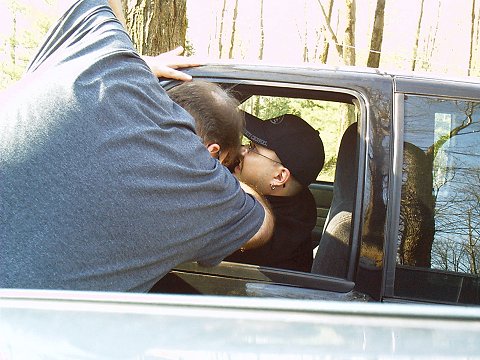
He yanks me into the vehicle to deliver a savage counterattack.
For the technique to work, , the carjacker must put his firearm in range. If he’s out of range and you cannot move your vehicle at all, you’re out of luck.
PROJECTILES ARE DOUBLE-EDGED
A firearm is a very effective, very powerful self-defense tool. It is also an extremely serious threat when pointed in your direction. No counter to an armed confrontation is without extreme risk. You may hot have a choice, though, given the situation. In all cases you must weigh the possibility of death against the benefits or liabilities of compliance with an assailant’s demands.
Keep your wits about you and do what you must.
Well done, Phil. I agree that in gun defense, your main priority is to not get shot, which means redirecting the weapon and stepping off line. I personally prefer controlling the weapon or weapon hand with both of my hands. The reason being, if the other man is bigger or stronger, and is putting up resistance, I would rather sacrifice my ability to mount a counter-offensive in favor of better grip on the weapon. By using a fast, violent twist of the body, you can then rip the weapon away, or possibly snap the arm at the elbow.
I’d like to see some videos of this done, especially the RCAT technique. And the car.
One thing I’d like to mention: avoid ‘disarming.’ Rather than getting the weapon away from the opponent, you should focus of making sure he can’t hold a weapon, i.e. breaking his arm or some fingers. You have no idea how many weapons he has. Just getting one away does not mean you are safe.